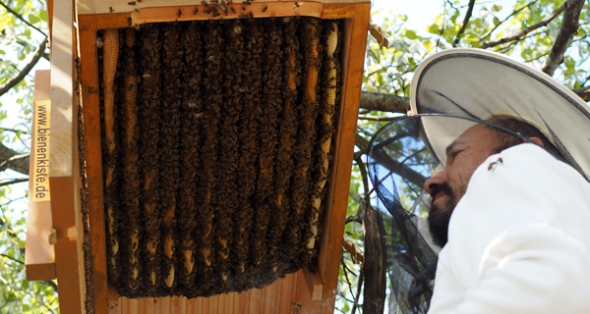Biologist and biodiversity researcher Dr Casper Schönig manages a number of urban beehives around Berlin, including some we visited in the garden at Cafe Botanico over the weekend. He traces the tradition of beekeeping in Berlin through to the DDR, when honey functioned as an alternative currency and could be sold back to the state at a fixed price (Annette Mueller, founder of Berliner Honig, an association of local beekeepers, tells a similar story). Following the fall of the wall, urban hives dropped out of use as other economic opportunities arose, contributing to the decline of the local bee population. Schönig is skeptical about the significance of Colony Collapse Disorder in Europe, and indeed about any overgeneralised approach to the various problems faced by bees in different parts of the world. Though today in Berlin there is only one-third of the number of city beehives active in the 1950s, it seems that urban beekeeping is currently experiencing something of a revival, following campaigns such as Berlin Summt! to install beehives on rooftops around the city.
Germans are in fact amongst the world’s largest consumers of honey. Claire Preston in her contribution to the Reaktion book series on animals, Bee (2006), claims Germans consume up to 4.3 kg of honey per capita compared to 0.5 kg in the US (citing figures from the American National Honey Board; Preston 2006, p. 48).

Image sourced from Prinzessinnengarten blog.
At Prinzessinnengarten, beekeeper Heinz maintains foundationless hives, foregoing the pressed wax comb templates that are common to domestic hives. Ridges on the inside of the roof of his hanging ‘coffin beehive’ provide prompts for the bees to build combs orderly enough for Heinz to inspect and rob. He believes that the smaller combs built in these hives allows for better protection against parasites like the notorious Varroa mite. The brood occupies the front section of the box which Heinz accesses from below, and can expand into the rear of the kiste to store honey. Heinz claims these hives also allow more room for the bees to perform their waggle dance. Heinz doesn’t prevent his bees from swarming, nor does he remove the drones, and only minimally intervenes for hive maintenance, using organic acids seasonally to protect against parasites. He harvests honey once in the season, usually around mid-summer, to allow the bees time to replenish their honey stocks before they ‘overwinter’, preferring not to feed them sugar water or supplements.
Nebraskan beekeeper Michael Bush endorses a similar approach of ‘lazy beekeeping’ that simply allows bees to do their thing with minimal interference. Bush, like Heinz, believes these methods result in healthier, cleaner hives and encourage stronger strains of bees to flourish.
North America is afflicted by Colony Collapse Disorder (CCD), the threat of Africanised Honey Bees and numerous other pests and diseases, which have led beekeepers to become reliant on pesticides and regulatory processes. Bush observes that the depletion of localised feral bee populations and beekeepers buying queens from a small group of breeders has resulted in a significant reduction of the bee gene pool on the continent. Rather than practice such precarious methods, Bush has sought other means by which to keep his hives free of mites and diseases. He now maintains what he calls ‘natural comb’ hives, producing smaller combs than those made by ‘normal’ bees, and advocates for others to similarly regress their hives. By removing the template wax combs from hives and allowing bees to draw their own, successive generations of bees become smaller. This approach to beekeeping, while still a means of harvesting honey for human consumption, emphasises healthier hives and stronger bee generations over maximum honey yields, and might be considered more benign(!).
Might such shifting dispositions represent an entry point from which to think about an interspecies ecologically-focused approach to urban agriculture, economics, science and politics?
